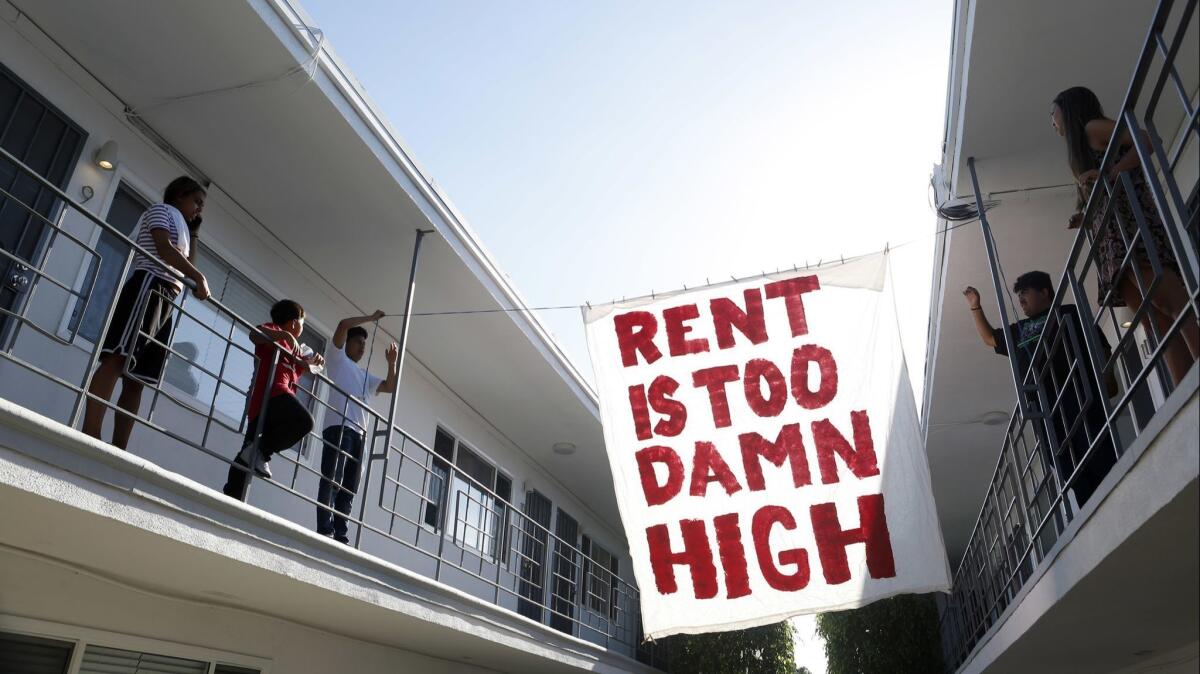California cities lead the U.S. in inflation. Housing costs are a big reason why

Nationally, consumer prices are barely moving, with inflation clocking in at just 1.8% for May. But if you live in a major urban area of California, you’ve noticed a much bigger hit.
Among the chief culprits? Housing costs.
The U.S. Bureau of Labor Statistics reported Wednesday that a handful of California metropolitan areas saw the greatest jump in the consumer price index in May. San Diego County saw the largest increase, with inflation over the past year of 3.8%. That was followed by Los Angeles and Orange counties, where consumer prices rose 3.1%.
In the Inland Empire counties of Riverside and San Bernardino, the inflation index climbed 2.9%. The San Francisco Bay Area, where the latest data is from April, saw consumer prices jump 4%.
To some extent, the latest reports drive home the state’s housing affordability crisis.
“Housing has a huge weight in the index,” said Lynn Reaser, chief economist of the Fermanian Business and Economic Institute at Point Loma Nazarene University in San Diego. “The problem is we are not building houses rapidly enough to accommodate the increase in demand.”
That demand is coming from a growing economy. And Pepperdine University professor Dave Smith said the fact California cities dominate the national inflation measure is a reflection that “economic activity is robust in these given areas and it’s putting upward pressure on prices.”
Mandated minimum-wage increases and a tight labor market are forcing employers to pay higher wages too, and they’re passing at least some of that along to consumers, said Christopher Thornberg, founding partner of Beacon Economics.
Data from May aren’t yet available, but in April average hourly earnings in Los Angeles and Orange counties rose 7% from a year earlier, to $31.60. In the Inland Empire, which has seen a boom in logistics and warehouse employment, wages rose 6.2%. In San Diego County, wages were essentially flat, but economists said that may be a statistical anomaly.
Other consumer prices rose as well. In Los Angeles and Orange counties, energy costs, largely reflecting gasoline, jumped 5.9% in May. Household furnishings and operations, including landscape services and furniture, rose 5.7%. Food prices rose 2.9%.
The pace of rent growth has accelerated from last year in Los Angeles and Orange counties, rising 5.4% in May, Bureau of Labor Statistics data show. That mirrors other data from Zillow that indicate the median rent price in both counties has started increasing again after declining slightly at the end of 2018.
Overall inflation in Los Angeles and Orange counties has moderated since last year, when the annual average increase in consumer prices was 3.8%, Bureau of Labor Statistics data show.
Wage increases will help people afford higher prices, but they’re unlikely to fundamentally change the situation of many Californians living on the edge.
“Tenants are caught in an economic vise that is squeezing them more and more,” said Larry Gross, executive director of the Coalition for Economic Survival.
Across California, more than 1.7 million households spent more than half their income on rent and utilities in 2017, according to the latest data from Harvard University’s Joint Center for Housing Studies. And last week, officials reported the number of people without a home in L.A. County jumped 12% over the last year.
Cities have recently announced a variety of actions that they say will help make housing more affordable.
On Tuesday, several Los Angeles City Council members proposed a tax on property owners who keep units vacant. And the Inglewood City Council approved a rent-control measure that would cap annual increases at 5% for many properties.
State legislators have also taken steps, but a number of high-profile bills died this year or were significantly neutered. Among the bills that failed was Senate Bill 50, which would have allowed at least four units on parcels in most single-family neighborhoods across the state. A rent-cap measure is still in play in the Legislature, but has been watered down.
Increases in the consumer price index can have wider consequences for renters in rent-controlled buildings because cities peg allowable increases to the inflation measure. Starting July 1, landlords of rent-controlled buildings in Los Angeles will be able to increase rents by 4%, the first time the allowable increase has topped 3% since 2009.
Follow me @khouriandrew on Twitter
More to Read
Inside the business of entertainment
The Wide Shot brings you news, analysis and insights on everything from streaming wars to production — and what it all means for the future.
You may occasionally receive promotional content from the Los Angeles Times.










